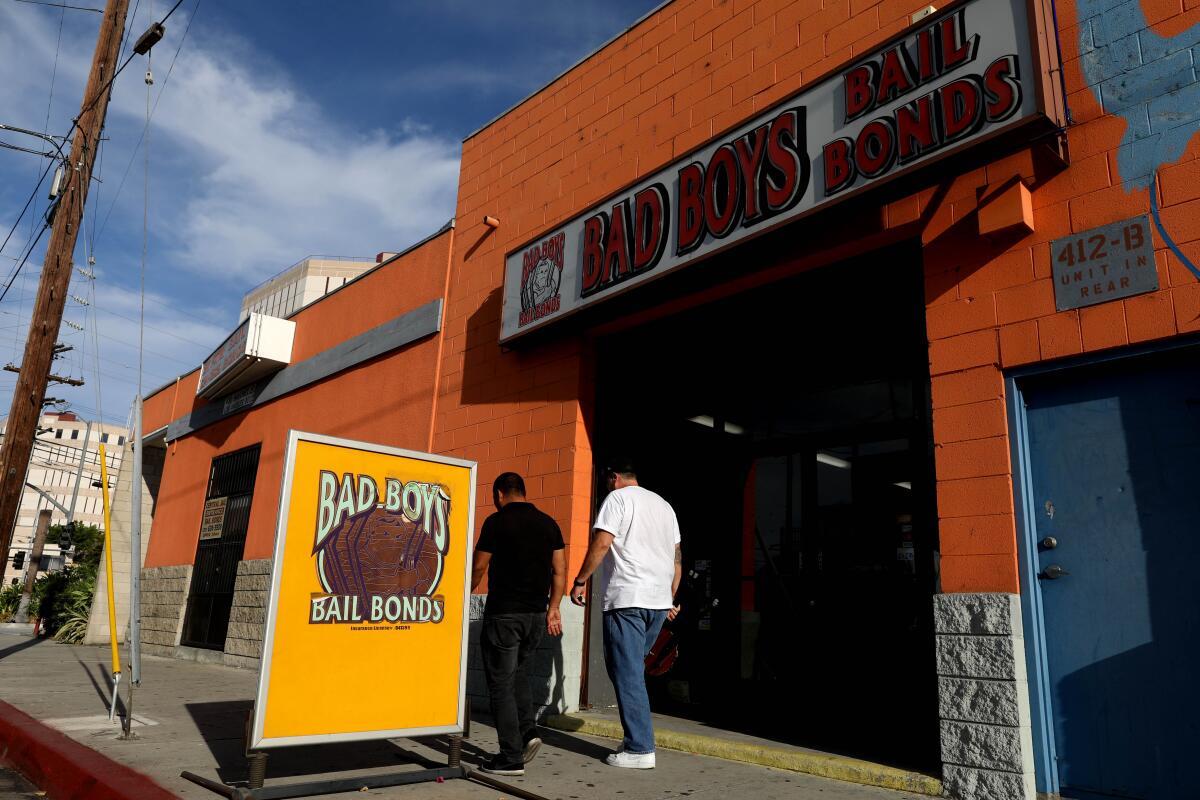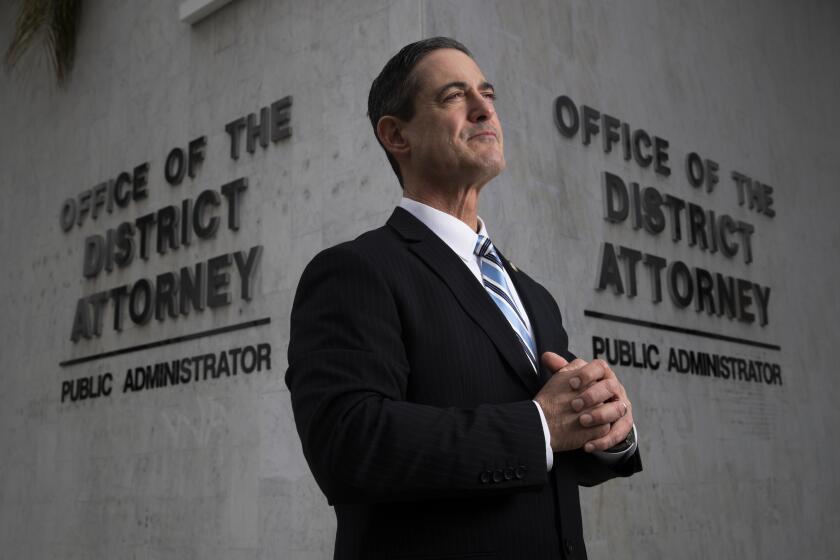Editorial: ‘Zero bail’ and release from jail are not the same thing

- Share via
Violent crime is up in California and around the nation, and many prosecutors, politicians and police officials place the blame — incorrectly — on so-called “zero-bail” policies and other changes to the traditional money bail system.
Their arguments are seductive because they are so easy to follow, inaccurate though they may be: The claim is that we reduced or eliminated the requirement that people accused of crimes be held in jail until trial unless they deposit money with the court. They argue that now criminal suspects who are arrested don’t have to pay anything before being immediately and unconditionally released, leaving them free to keep committing the same crimes over and over without any consequences.
Separate the facts from the falsehoods, and the different programs from one another, and bail reform makes a lot more sense as a necessary route to a higher quality of justice and better community safety.
California’s emergency zero-dollar bail order does not force officials to turn criminals loose on the public.
The first thing to note is that unlike on TV, where an arrested person is brought before a judge who holds a hearing, considers evidence and listens to arguments before setting bail, it seldom works that way in real life.
In California, bail amounts for various crimes are preset by each trial court, which are published on a sort of rate sheet or “schedule.”
After a person is arrested, he or she is brought to a police station, the schedule is consulted and the suspect is advised (without a defense lawyer, a prosecutor or a judge present) how much to pay in order to be released. The police direct the suspect to a list of bail bond agents, one of whom arranges to pay the amount listed on the schedule, for a nonrefundable percentage. If the suspect can’t pay the percentage, he or she is sent to county jail until trial.
The so-called “$0 bail” program, later shortened in common usage to “zero bail,” originally described a statewide emergency health and safety program that lasted just a few weeks in 2020 at the beginning of the pandemic. Judicial branch leaders ordered courts to reduce bail amounts for misdemeanors and lower-level felonies to zero to temporarily reduce jail populations in order to stem the spread of COVID-19 among inmates and their families and neighbors.
Critics, including the state sheriff’s association, don’t seem to know how bail works.
The emergency order expired in June 2020. A state bill to make $0 bail permanent failed in the Legislature last year.
Some trial-level courts, including the Los Angeles County Superior Court, adopted their own COVID emergency bail measures for misdemeanors and low-level felonies that remain in effect, and those programs are also sometimes referred to as “zero bail” — although they are often conflated with the now-expired statewide program. Judges retain their right to order defendants to be held without bail on a case-by-case basis.
But to do that, there has to be a hearing, and there often isn’t one. A defendant in custody for two or more business days has to be brought before a judge. But if the person made bail, or if bail was set at $0, there’s no hearing requirement. The district attorney and the courts may not be aware of the arrest or the release, or get involved in the case at all, for weeks.
So it’s conceivable that a person who poses a danger and should not have been released will be at large. But that would be the case even with the old bail schedule in effect, assuming the defendant had the money to bail out.
The problem isn’t that poor people now can be released as readily as rich people. That’s actually a great improvement in the sense that the system now comports better with American values of equal justice.
The problem is that the police, prosecutorial and courts procedures were all premised on the assumption that most accused people won’t be able to pay their bail. The system that was supposed to ensure that most suspects get out of jail before trial, while keeping the most dangerous ones in, instead was used to keep almost everyone in. Now that those accused of low-level crimes are getting out — as they should — they may be joined by a few people who should have been first brought before a judge. It’s important to remember that people accused of serious and violent crimes are not being released without either paying bail or coming before a judge, just as before.
In an entirely separate set of reforms that began well before the pandemic, some counties and courts (including Los Angeles) began studying how to get rid of money bail altogether, permanently, for people accused of lower-level crimes.
When crafted with wisdom, these programs can eliminate the unfairness of wealthy accused people going free while impoverished people, accused of the very same crimes, stay locked up.
One important point to note about these programs is that most are still on the drawing board. They have not been implemented in Los Angeles County.
Some district attorneys, including L.A. County’s George Gascón, no longer seek bail in misdemeanor cases. But remember, the D.A. has no jurisdiction during the crucial first few hours and days following the arrest. Bail decisions are made at a police station or the bail bond agent’s office. If the suspect remains in custody for more than two business days, there will be a hearing, and the D.A. will get involved. But when the suspect bails out, it could be weeks before the D.A. even learns of the case.
Also, the Los Angeles County D.A. doesn’t even have jurisdiction over many misdemeanors. In the city of L.A. and several other municipalities, the city attorney handles misdemeanors and decides whether to ask for bail.
There’s an additional, and very important, twist: Last year, the state Supreme Court struck down the “common practice of conditioning freedom solely on whether an arrestee can afford bail.”
In People vs. Humphrey, the court said alternative conditions of release such as electronic monitoring or drug treatment could generally protect public safety while ensuring the defendant’s appearance at trial. The Humphrey ruling still allows money bail, but only after considering the defendant’s ability to pay it. People may no longer be locked up solely because they can’t afford bail.
If there is any link between crime and the reduction or elimination of bail requirements, the problem is not in the policies themselves, but in the fact that police, the courts and others in the criminal system built their procedures around the suspect’s inability to pay. Fixing that problem will require all of those agencies to communicate better and more quickly with one another while guaranteeing public safety and the rights of accused people.
More to Read
A cure for the common opinion
Get thought-provoking perspectives with our weekly newsletter.
You may occasionally receive promotional content from the Los Angeles Times.












